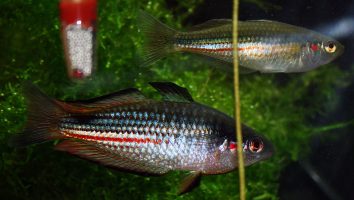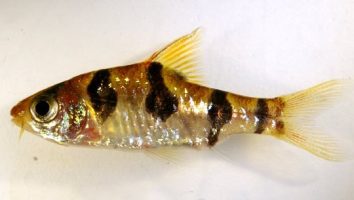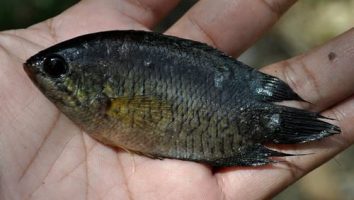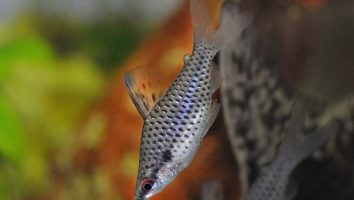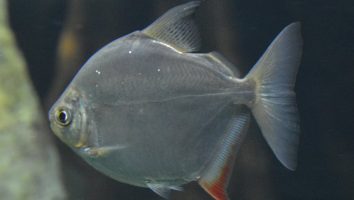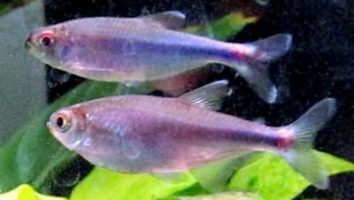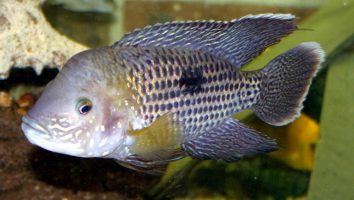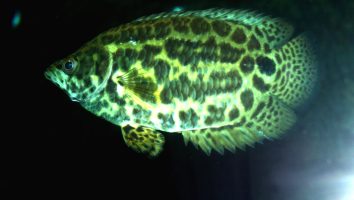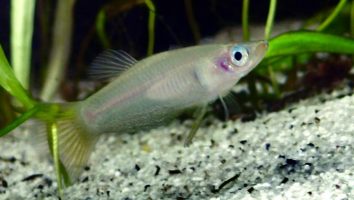The rainbow shark is a freshwater fish that is native to Southeast Asia.
They are a popular fish in the aquarium trade due to their vibrant coloration and active personality.
However, they are also a very territorial fish and can be aggressive towards other tank mates.
Because of this, it is important to do your research before adding a rainbow shark to your tank. In this guide, we will teach you everything you need to know about rainbow shark care.
Table of contents
Species overview
Rainbow Sharks (Epalzeorhynchos frenatum) are a freshwater fish that is native to Southeast Asia. In the wild, they are found in the Chao Phraya River basin in Thailand as well as some parts of Laos, Cambodia, and Vietnam.
These fish prefer still or slow-moving waters with plenty of places to hide. This could be in the form of plants, driftwood, or rocks.
Rainbow sharks are known to be quite territorial and aggressive, especially toward their own species. For this reason, it’s best to only keep one per tank unless the tank is very large.
These fish are beautiful and have a unique coloration that makes them stand out in any aquarium. They are a popular choice for many fishkeepers.
Appearance
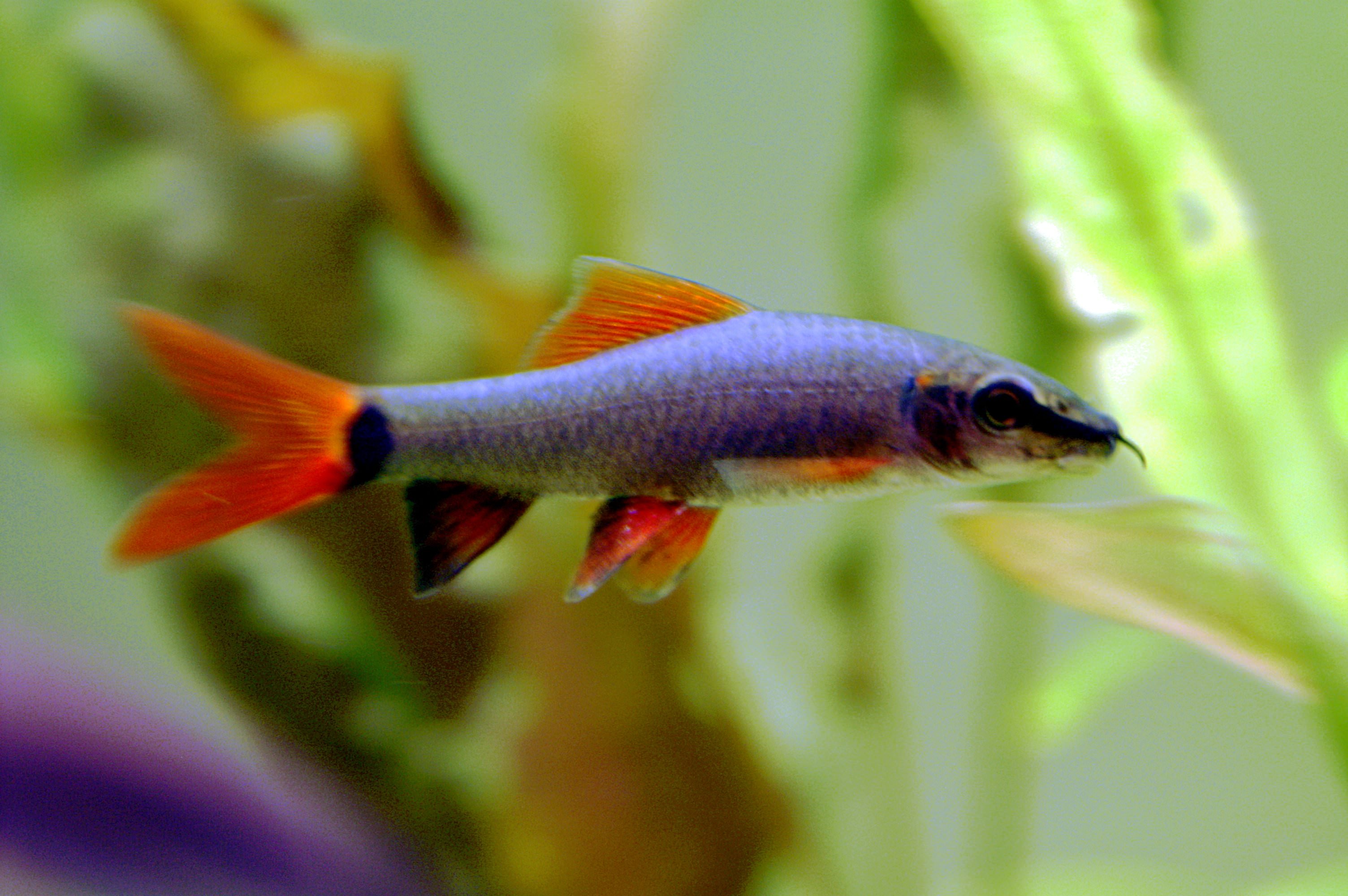
The first thing you’ll notice about the Rainbow Shark is their coloration. As you might’ve guessed, this fish is adorned with a beautiful array of colors.
The base color of their body is usually a dark gray or black. This is then highlighted with electric blue stripes that run horizontally along their sides.
The fins on this species are also very colorful. The dorsal fin has a black base with blue stripes running along the edges. The anal fin is similar but it doesn’t have the blue stripes.
The caudal fin is forked and very tall. The top half is black while the bottom half is brightly colored with blue and orange.
The pectoral fins are orange with black tips. The ventral fins are also orange but they don’t have the black tips.
Rainbow Sharks have very large eyes that almost seem to bulge out of their heads. They also have a very long and pointy nose.
Lifespan
In the wild, rainbow sharks typically only live for 3 to 5 years. In captivity, however, they have the potential to live much longer – up to 15 years!
The key to a long lifespan for your rainbow shark is to provide them with the best possible environment. This means a large tank with plenty of hiding places, good water quality, and the right diet.
Size
The average size of a Rainbow Shark is between 5 and 6 inches long, with some specimens reaching up to 8 inches. They are a relatively slender fish, so they don’t need a ton of space to swim around.
Tank
Tank Size
The recommended minimum tank size for a rainbow shark is 50 gallons. If you want to keep more than one shark in the same tank you’ll need to add an additional 30 gallons for each fish.
This is a semi-aggressive fish so it’s important to give them plenty of space to establish their own territory. They are also known to be jumpers so you’ll need to make sure your tank is covered.
Water Parameters
The rainbow shark is a freshwater fish that requires specific water parameters to stay healthy in captivity.
These fish are native to the fast-flowing rivers of Southeast Asia. In the wild, they’re used to water with a high oxygen content and a moderate pH.
Captive rainbow sharks do best in an aquarium that’s at least 50 gallons in size. A larger tank is even better since these fish are known to be aggressive toward tank mates. They also need plenty of hiding places to feel secure.
The water parameters below are a good starting point for a healthy rainbow shark habitat.
- Water temperature: 76 to 82 degrees Fahrenheit
- pH levels: 6.8 to 7.2
- Water hardness: 10 to 20 dGH
- Alkalinity Levels: 4 to 8 dKH
What To Put In Their Tank
When it comes to setting up the tank for a Rainbow Shark there are a few key things that you need to take into account.
First and foremost, these fish are known to be fairly aggressive. They’re not the type that will kill other fish outright, but they can nip and harass tank mates quite a bit (especially if the tank is too small).
Because of this, we recommend setting up their tank with plenty of hiding spots. This can be in the form of rocks, driftwood, plants, or even caves.
The more places there are for your fish to hide the better. This will help reduce stress levels and make it less likely for them to lash out.
It’s also important to have a good amount of space for them to swim around in. A Rainbow Shark that feels cramped is going to be a lot more likely to be aggressive.
As far as the substrate goes, these fish don’t really have any preferences. You can use gravel, sand, or even a bare bottom tank if you wish.
Common Diseases
While rainbow sharks are a generally hardy fish, they are susceptible to a few diseases. The most common one is ich, which is a parasites that affects fish.
This disease manifests itself as white spots on the body of the fish. If left untreated, it can quickly lead to death.
The best way to treat ich is to raise the temperature of the water in the tank. This will speed up the life cycle of the parasite, and the fish will be able to fight it off more easily.
You’ll also need to do a water change and remove any carbon from the filter.
Another disease that can affect rainbow sharks is hole-in-the-head disease. This is caused by poor water quality and the presence of activated carbon in the tank.
It manifests itself as pits or holes in the head of the fish. While it’s not usually fatal, it can be quite unsightly.
The best way to treat hole-in-the-head disease is to improve the water quality in the tank and remove the activated carbon from the filter.
Behavior & Temperament
The rainbow shark is a beautiful, but semi-aggressive freshwater fish. It’s not recommended for beginner aquarists because of its territorial nature. These fish are known to chase and nip at other tank mates, so they should only be kept with other aggressive fish.
The rainbow shark is a timid fish that likes to hide, so it’s important to provide plenty of hiding spots in the tank. If the fish doesn’t have a place to retreat to, it will become stressed and may become ill.
These fish are also known to be jumpers, so it’s important to have a tight-fitting lid on the tank.
Rainbow sharks are active at night, so you may not see them much during the day. When they are out and about, they like to explore their environment and may even nibble on plants.
Tank Mates
The main issue with finding tank mates for a Rainbow Shark is that the species is notoriously aggressive.
This fish is known to nip at the fins of other fish and can cause real damage if left unchecked. As a result, it’s important to find fish that can hold their own against a Rainbow Shark.
The good news is that there are plenty of fish that fit this bill. The bad news is that most of them are on the large side.
Here are some examples of fish that can stand up to a Rainbow Shark:
- Oscar
- Green Terror
- Jack Dempsey
- Firemouth Cichlid
- Convict Cichlid
- Blood Parrot Cichlid
- Redtail Catfish
- Plecos
- Arowana
Breeding
Rainbow sharks are one of the more difficult fish to breed in captivity. They’re not impossible, but it takes a little more effort than some other species.
The first step is to set up a breeding tank. It should be at least 50 gallons and well-filtered. Then, add some plants and hiding places. Driftwood is a good choice.
The next step is to find a pair of sharks. This can be difficult since they’re not always easy to sex. The best method is to look at the size and shape of the fins. Males have longer and more pointed fins.
When you’ve found a pair, add them to the tank. Then, begin making water changes. Rainbow sharks are triggered to spawn by large water changes. The female will lay her eggs in the plants. The male will then fertilize them.
After about a week, the eggs will hatch. Remove the adults from the tank at this time. They will eat the fry if given the chance.
The fry will feed on microscopic organisms in the water. You can supplement this with baby brine shrimp. As they grow, you can gradually transition them to flakes and pellets.
Conclusion
The Rainbow Shark is a beautiful and popular freshwater fish that is native to Thailand.
Despite their name, they are not actually sharks. They are a type of freshwater fish known as a cyprinid.
Rainbow Sharks are a semi-aggressive fish that should only be kept with other fish that can hold their own. They are known to nip at the fins of other fish and can be territorial.
Rainbow Sharks are a hardy fish that are relatively easy to care for. They are a good choice for beginner fish keepers that have some experience with other freshwater fish.

